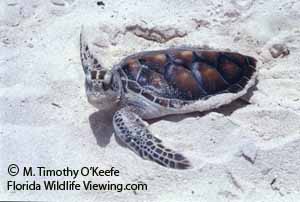Essentials
Home
Where to Go
When to Go
Animal Facts
Photo Gallery
Photo Tips
Kids' Corner
______________
Activities
Florida Birding
Birding Optics
Florida Camping
Kayaking
Nature Festivals
Florida Hiking
Nature Webcams
______________
Florida Travel
Florida Ecotourism
Travel Insurance
Florida Maps
Florida Weather
___________
About Us
Disclaimer
Copyright Notice
Site Search
|
|
Sea Turtles
An Ancient Species
The earliest
sea turtle fossils date back about 150,000,000
years, to a time when vast shallow seas covered
much of the earth.
Sea turtles adapted in several specialized ways because of their watery
habitat. Their forelimbs are sleek and paddle-like
to propel them swiftly through the ocean. Their shells are
more streamlined and less boxy than many land species. (See Nesting Sea Turtle Photos)

Green turtle hatchling struggling to
reach the water
SEA TURTLE CHARACTERISTICS
Because they spend almost their entire lives in the water, sea turtles developed
more than just lungs for breathing.
They are able to
exchange oxygen and carbon dioxide with the surrounding water thanks
to extensive capillary vascularization in their cloacal
cavity, and their buccal cavity.
By circulating water in these cavities and also by reducing
their metabolism dramatically, sea turtles can stay submerged from between
40 minutes to five hours if they are not active and
the water is not too warm.
Sea
turtles do not have teeth.
Their bird-like beaks and
jaws are quite powerful, able to crush, tear or chew food with little
problem. Like all reptiles, sea turtles lack external ears. Instead,
the sea turtle eardrum is covered over by skin. With
a few exceptions, male sea turtles spend 100 percent of their lives
in the ocean.
Female sea urtles have only one need of
the land: to deposit their eggs. Adult sea turtles are solitary creatures
most of the time. Their only true social interaction
is said to occur during courtship and mating.
To Page 3 Sea Turtle Birth & Migrations
To Florida Animals & Wildlife Home
To Where to See Nesting Sea Turtles
To Sea Turtle Homepage
|
|

